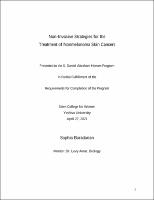Please use this identifier to cite or link to this item:
https://hdl.handle.net/20.500.12202/6904| Title: | Non-Invasive Strategies for the Treatment of Nonmelanoma Skin Cancers |
| Authors: | Amar, Levy Baradarian, Sophia |
| Keywords: | seniors honors thesis cancer treatment nonmelanoma skin cancers (NMSC) dermatological malady cutaneous neoplasms basal cell carcinoma (BCC) squamous cell carcinoma (SCC) keratinocyte carcinomas surgical resection cutaneous melanoma (CM) American Academy of Dermatology (AAD) |
| Issue Date: | 27-Apr-2021 |
| Citation: | Baradarian, Sophia. (2021, April). Non-Invasive Strategies for the Treatment of Nonmelanoma Skin Cancers {Bachelor's honors thesis, Yeshiva University]. |
| Abstract: | Introduction: The most common dermatological malady among Caucasians is skin cancer. Cutaneous neoplasms may be classified into two distinct classes: melanoma and nonmelanoma skin cancer (NMSC). The latter consists of two primary histological subcategories, namely basal cell carcinoma (BCC) and squamous cell carcinoma (SCC), both of which are keratinocyte carcinomas. For decades, surgical resection has been the leading course of treatment for both MSC and NMSC malignancies. Nevertheless, the performance of surgery may be impacted by various considerations, including comorbidities of the patient, the anatomical site of the lesion, potential intolerance for repeated tissue excisions to ensure complete elimination of the cancer, and patient care setting. Due to the aggressive metastatic ability and consequent mortality of cutaneous melanoma (CM), there is not much variety in the proposed treatment methods for the care and eradication of this cancer. In its clinical guideline for the treatment of CM, the American Academy of Dermatology (AAD) advocates for surgical excision of the tumor to maximize patient survivability. While surgical removal is a feasible management option for NMSCs as well, the lesser-malignant nature of such lesions may allow for greater leeway in the realm of treatment. Although available treatments of BCC and SCC are generally effective in eradicating cancer, some of their disadvantages include the incomplete resection of the growth, poor postoperative quality of life implications, limited cosmetic results, and costliness. Due to globally escalating rates of NMSC presentation, the development of noninvasive treatment methods is imperative. Methods: Twenty-five years’ worth of published medical literature (1995–2021) was evaluated using PubMed and Google Scholar databases. Both surgical and noninvasive treatment modalities were examined, with particular emphasis allocated to the collection of data on novel therapies in the care and management of NMSC therapy. Data: This review will address and delineate current, non-invasive strategies for the treatment of nonmelanoma skin tumors. Additionally, it will introduce emerging noninvasive treatments that may have therapeutic implications in the realm of typically nonfatal cutaneous cancers. Results and Discussion: The development of noninvasive therapies has drastically changed the face of skin cancer management. Nonsurgical treatments including imiquimod, 5-fluorouracil, radiation therapy (RT), as well as photodynamic therapy (PDT) have gained greater use in the care and management of NMSC. Moreover, cannabinoids as well as topical formulations derived from phytonutrient-rich plants of the genuses Armeniaca, Solanum, and Rubus are being increasingly considered for use in the primary and adjuvant treatment of non-fatal cutaneous malignancies. Such advancements have greatly enabled the conduction of further studies in the search for more effective and tissue-salvaging therapies for the treatment of NMSC. |
| Description: | Senior honors thesis / Open Access |
| URI: | https://hdl.handle.net/20.500.12202/6904 |
| Appears in Collections: | S. Daniel Abraham Honors Student Theses |
Files in This Item:
| File | Description | Size | Format | |
|---|---|---|---|---|
| Baradarian Sophia Honors Thesis 2021.pdf | 254.76 kB | Adobe PDF |  View/Open |
This item is licensed under a Creative Commons License

